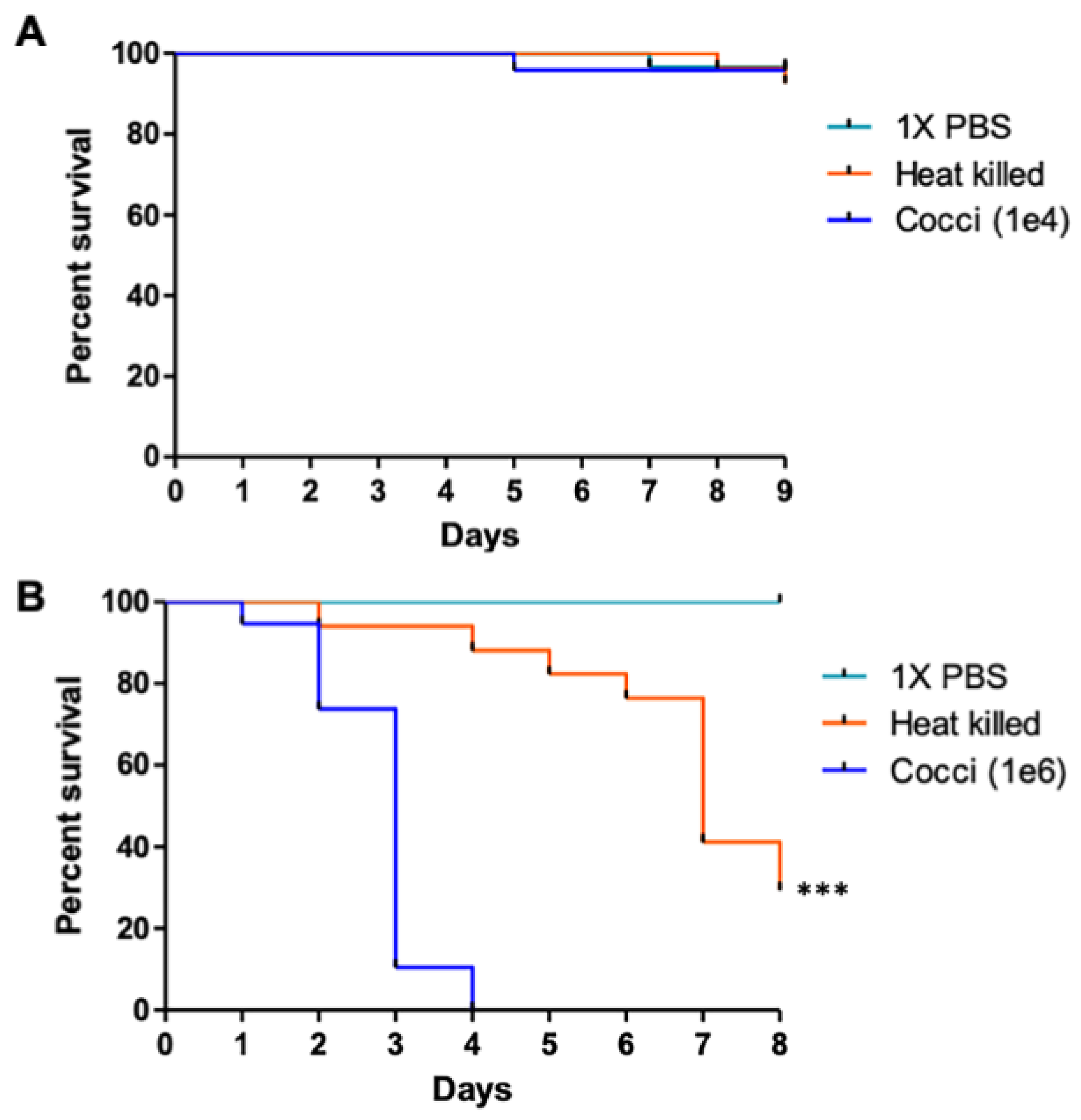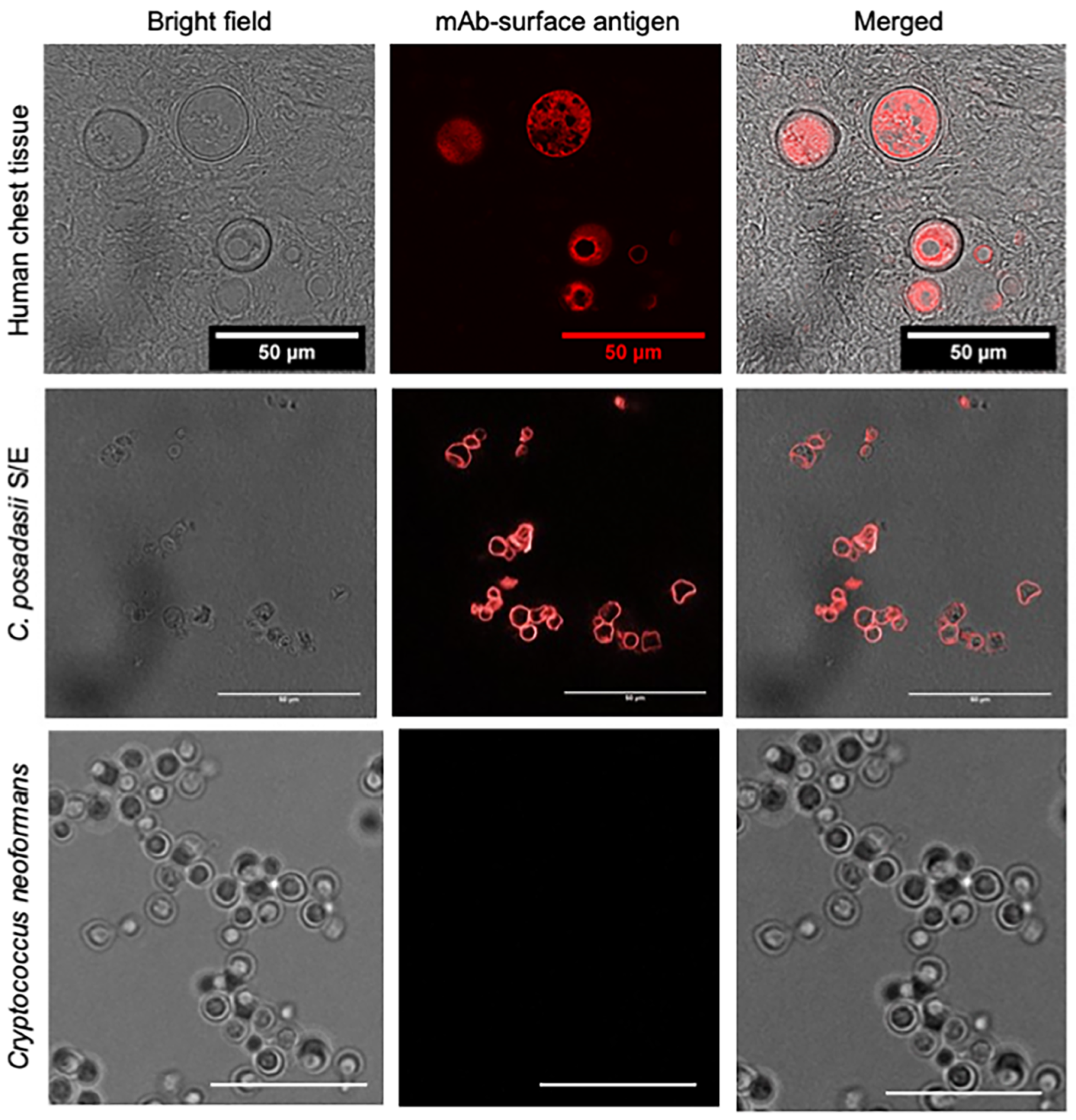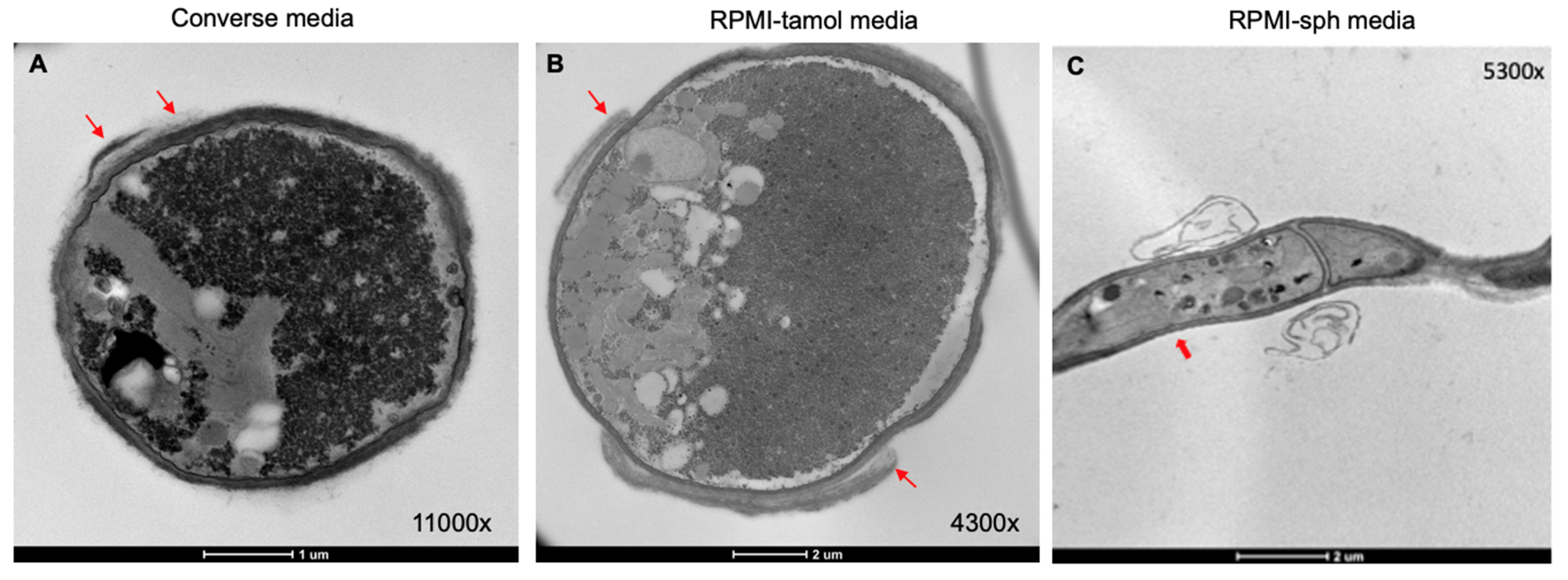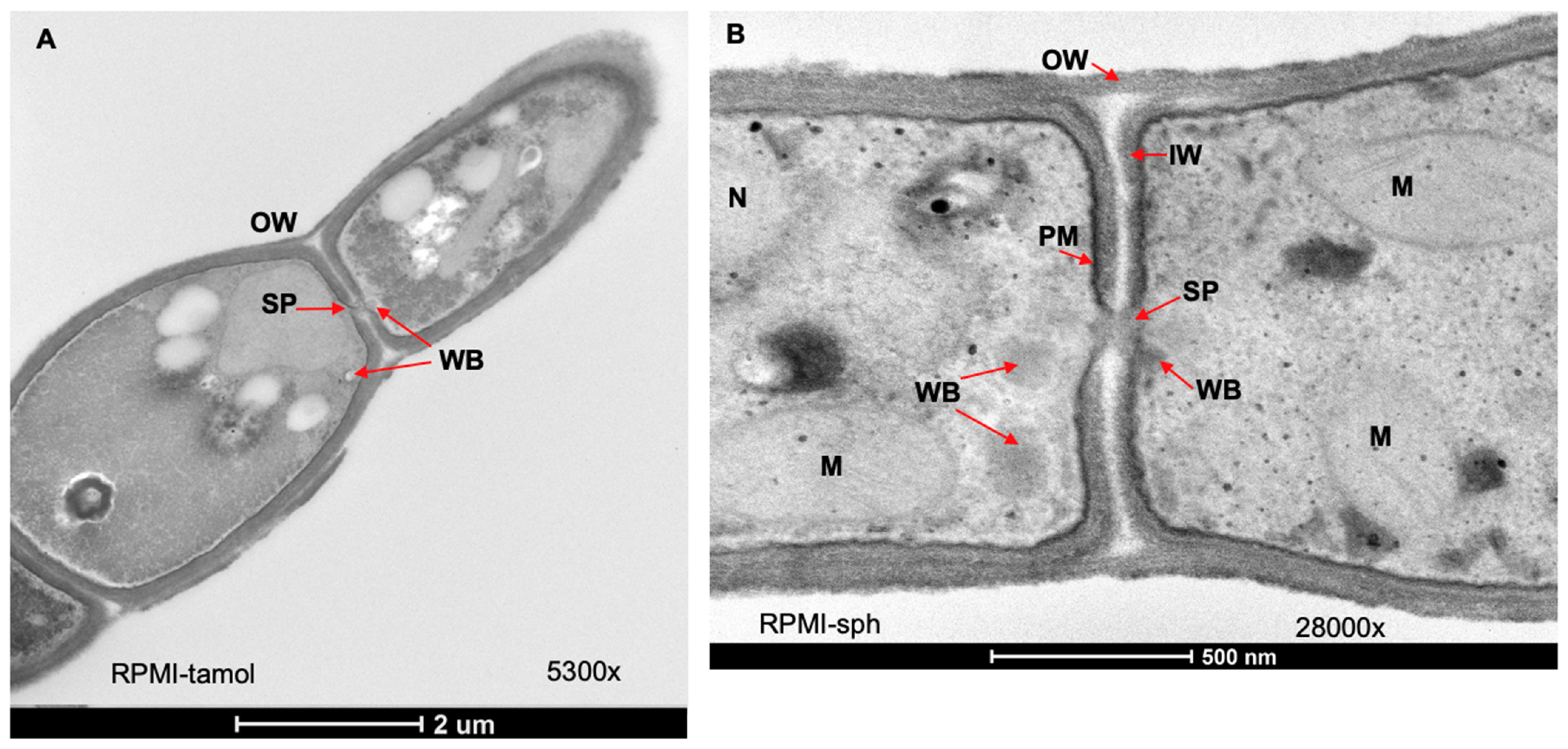Characterization of the Growth and Morphology of a BSL-2 Coccidioides posadasii Strain That Persists in the Parasitic Life Cycle at Ambient CO2
Abstract
:1. Introduction
2. Materials and Methods
2.1. Strains and Growth Conditions
2.2. Galleria Mellonella Killing Assay
2.3. Leica DIC DMRE Imaging
2.4. Enzymatic Release of Extracellular Proteins from S/E Phase Coccidioides
2.5. Mass Spectrometry Sequencing
2.6. Transmission Electron Microscopy
2.7. In Vitro Growth Kinetics
3. Results
3.1. C. posadasii S/E Spherules Are Virulent In Vivo
3.2. Similarity in Surface Antigens of Coccidioides Identified in Human Chest Tissue and C. posadasii S/E Strain
3.3. C. posadasii S/E Reverts to Mycelial Form in the Spherule-Producing Media, RPMI-Sph
3.4. Ultrastructural Features of C. posadasii S/E When Cultured in Different Media
4. Discussion
Supplementary Materials
Author Contributions
Funding
Institutional Review Board Statement
Informed Consent Statement
Data Availability Statement
Acknowledgments
Conflicts of Interest
References
- Stockamp, N.W.; Thompson, G.R., III. Coccidioidomycosis. Infect. Dis. Clin. N. Am. 2016, 30, 229–246. [Google Scholar] [CrossRef] [PubMed]
- Van Dyke, M.C.C.; Thompson, G.R.; Galgiani, J.N.; Barker, B.M. The Rise of Coccidioides: Forces Against the Dust Devil Unleashed. Front. Immunol. 2019, 10, 2188. [Google Scholar] [CrossRef] [PubMed]
- Brown, J.; Benedict, K.; Park, B.J.; Thompson, G.R., III. Coccidioidomycosis: Epidemiology. Clin. Epidemiol. 2013, 5, 185–197. [Google Scholar] [CrossRef] [PubMed] [Green Version]
- Ocampo-Chavira, P.; Eaton-Gonzalez, R.; Riquelme, M. Of Mice and Fungi: Coccidioides spp. Distribution Models. J. Fungi 2020, 6, 320. [Google Scholar] [CrossRef]
- Garcia-Solache, M.A.; Casadevall, A. Global warming will bring new fungal diseases for mammals. mBio 2010, 1, e00061-10. [Google Scholar] [CrossRef] [Green Version]
- Mitchell, N.M.; Sherrard, A.; Dasari, S.; Magee, D.M.; Grys, T.; Lake, D.F. Proteogenomic Re-Annotation of Coccidioides posadasii Strain Silveira. Proteomics 2018, 18, 1700173. [Google Scholar] [CrossRef]
- Whiston, E.; Wise, H.Z.; Sharpton, T.; Jui, G.; Cole, G.T.; Taylor, J.W. Comparative transcriptomics of the saprobic and parasitic growth phases in Coccidioides spp. PLoS ONE 2012, 7, e41034. [Google Scholar] [CrossRef] [PubMed] [Green Version]
- Mead, H.L.; Teixeira, M.M.; Galgiani, J.N.; Barker, B.M. Characterizing in vitro spherule morphogenesis of multiple strains of both species of Coccidioides. Med. Mycol. 2019, 57, 478–488. [Google Scholar] [CrossRef] [Green Version]
- Converse, J.L.; Besemer, A.R. Nutrition of the Parasitic Phase of Coccidioides Immitis in a Chemically Defined Liquid Medium. J. Bacteriol. 1959, 78, 231–239. [Google Scholar] [CrossRef] [Green Version]
- Petkus, A.F.; Baum, L.L.; Ellis, R.B.; Stern, M.; Danley, D.L. Pure spherules of Coccidioides immitis in continuous culture. J. Clin. Microbiol. 1985, 22, 165–167. [Google Scholar] [CrossRef] [Green Version]
- Lee, C.Y.; Iii, G.R.T.; Hastey, C.J.; Hodge, G.C.; Lunetta, J.; Pappagianis, D.; Heinrich, V. Coccidioides Endospores and Spherules Draw Strong Chemotactic, Adhesive, and Phagocytic Responses by Individual Human Neutrophils. PLoS ONE 2015, 10, e0129522. [Google Scholar] [CrossRef] [PubMed] [Green Version]
- Mylonakis, E.; Moreno, R.; El Khoury, J.B.; Idnurm, A.; Heitman, J.; Calderwood, S.B.; Ausubel, F.M.; Diener, A. Galleria mellonella as a model system to study Cryptococcus neoformans pathogenesis. Infect. Immun. 2005, 73, 3842–3850. [Google Scholar] [CrossRef] [PubMed] [Green Version]
- Vu, K.; Gelli, A. Astemizole and an analogue promote fungicidal activity of fluconazole against Cryptococcus neoformans var. grubii and Cryptococcus gattii. Med. Mycol. 2010, 48, 255–262. [Google Scholar] [CrossRef] [Green Version]
- Mead, H.L.; Blackmon, A.V.; Vogler, A.J.; Barker, B.M. Heat Inactivation of Coccidioides posadasii and Coccidioides immitis for Use in Lower Biosafety Containment. Appl. Biosaf. 2019, 24, 123–128. [Google Scholar] [CrossRef] [PubMed]
- Lunetta, J.M.; Simmons, K.A.; Johnson, S.M.; Pappagianis, D. Molecular cloning and expression of a cDNA encoding a Coccidioides posadasii Cu,Zn superoxide dismutase identified by proteomic analysis of the coccidioidal T27K vaccine. Ann. N. Y. Acad. Sci. 2007, 1111, 181–197. [Google Scholar] [CrossRef] [PubMed]
- Lunetta, J.M.; Pappagianis, D. Identification, molecular characterization, and expression analysis of a DOMON-like type 9 carbohydrate-binding module domain-containing protein of Coccidioides posadasii. Med. Mycol. 2014, 52, 591–609. [Google Scholar] [CrossRef]
- Johnson, S.M.; Kerekes, K.M.; Zimmermann, C.R.; Williams, R.H.; Pappagianis, D. Identification and cloning of an aspartyl proteinase from Coccidioides immitis. Gene 2000, 241, 213–222. [Google Scholar] [CrossRef]
- Tarcha, E.J.; Basrur, V.; Hung, C.Y.; Gardner, M.J.; Cole, G.T. A recombinant aspartyl protease of Coccidioides posadasii induces protection against pulmonary coccidioidomycosis in mice. Infect. Immun. 2006, 74, 516–527. [Google Scholar] [CrossRef] [Green Version]
- Lunetta, J.M.; Simmons, K.A.; Johnson, S.M.; Pappagianis, D. Molecular cloning and expression of a cDNA encoding a Coccidioides posadasii 1,2-alpha-mannosidase identified in the coccidioidal T27K vaccine by immunoproteomic methods. Ann. N. Y. Acad. Sci. 2007, 1111, 164–180. [Google Scholar] [CrossRef]
- Ahmed, R.; Kodgire, S.; Santhakumari, B.; Patil, R.; Kulkarni, M.; Zore, G. Serum responsive proteome reveals correlation between oxidative phosphorylation and morphogenesis in Candida albicans ATCC10231. J. Proteom. 2018, 185, 25–38. [Google Scholar] [CrossRef]
- Feng, Q.; Summers, E.; Guo, B.; Fink, G. Ras signaling is required for serum-induced hyphal differentiation in Candida albicans. J. Bacteriol. 1999, 181, 6339–6346. [Google Scholar] [CrossRef] [PubMed] [Green Version]
- Martin, R.; Moran, G.P.; Jacobsen, I.D.; Heyken, A.; Domey, J.; Sullivan, D.J.; Kurzai, O.; Hube, B. The Candida albicans-specific gene EED1 encodes a key regulator of hyphal extension. PLoS ONE 2011, 6, e18394. [Google Scholar] [CrossRef] [PubMed] [Green Version]
- Fee, H.J.; McAvoy, J.M.; Michals, A.A.; Gold, P.M. Unusual manifestation of Coccidioides immitis infection. J. Thorac. Cardiovasc. Surg. 1977, 74, 548–550. [Google Scholar] [CrossRef]
- Fiese, M.J.; Cheu, S.; Sorensen, R.H. Mycelial forms of Coccidioides immitis in sputum and tissues of the human host. Ann. Intern. Med. 1955, 43, 255–270. [Google Scholar] [CrossRef] [PubMed]
- Puckett, T.F. Hyphae of Coccidioides immitis in tissues of the human host. Am. Rev. Tuberc. 1954, 70, 320–327. [Google Scholar] [CrossRef]
- Putnam, J.S.; Harper, W.K.; Greene, J.F., Jr.; Nelson, K.G.; Zurek, R.C. Coccidioides immitis. A rare cause of pulmonary mycetoma. Am. Rev. Respir. Dis. 1975, 112, 733–738. [Google Scholar] [CrossRef]
- Thadepalli, H.; Salem, F.A.; Mandal, A.K.; Rambhatla, K.; Einstein, H.E. Pulmonary mycetoma due to Coccidioides immitis. Chest 1977, 71, 429–430. [Google Scholar] [CrossRef]
- Dolan, M.J.; Lattuada, C.; Melcher, G.; Zellmer, R.; Allendoerfer, R.; Rinaldi, M. Coccidioides immitis presenting as a mycelial pathogen with empyema and hydropneumothorax. J. Med. Vet. Mycol. 1992, 30, 249–255. [Google Scholar] [CrossRef]
- Munoz-Hernandez, B.; Martinez-Rivera, M.A.; Palma Cortes, G.; Tapia-Diaz, A.; Manjarrez Zavala, M.E. Mycelial forms of Coccidioides spp. in the parasitic phase associated to pulmonary coccidioidomycosis with type 2 diabetes mellitus. Eur. J. Clin. Microbiol. Infect. Dis. 2008, 27, 813–820. [Google Scholar] [CrossRef]
- Munoz-Hernandez, B.; Palma-Cortes, G.; Cabello-Gutierrez, C.; Martinez-Rivera, M.A. Parasitic polymorphism of Coccidioides spp. BMC Infect. Dis. 2014, 14, 213. [Google Scholar] [CrossRef] [Green Version]
- Kaufman, L.; Valero, G.; Padhye, A.A. Misleading manifestations of Coccidioides immitis in vivo. J. Clin. Microbiol. 1998, 36, 3721–3723. [Google Scholar] [CrossRef] [Green Version]
- Hagman, H.M.; Madnick, E.G.; D’Agostino, A.N.; Williams, P.L.; Shatsky, S.; Mirels, L.F.; Tucker, R.M.; Rinaldi, M.G.; Stevens, D.A.; Bryant, R.E. Hyphal forms in the central nervous system of patients with coccidioidomycosis. Clin. Infect. Dis. 2000, 30, 349–353. [Google Scholar] [CrossRef] [PubMed]
- Vrabl, P.; Schinagl, C.W.; Artmann, D.J.; Heiss, B.; Burgstaller, W. Fungal Growth in Batch Culture-What We Could Benefit If We Start Looking Closer. Front. Microbiol. 2019, 10, 2391. [Google Scholar] [CrossRef]
- Fuchs, B.B.; Chaturvedi, S.; Rossoni, R.D.; de Barros, P.P.; Torres-Velez, F.; Mylonakis, E.; Chaturvedi, V. Galleria mellonella experimental model for bat fungal pathogen Pseudogymnoascus destructans and human fungal pathogen Pseudogymnoascus pannorum. Virulence 2018, 9, 1539–1547. [Google Scholar] [CrossRef] [Green Version]
- Trevijano-Contador, N.; Zaragoza, O. Immune Response of Galleria mellonella against Human Fungal Pathogens. J. Fungi 2018, 5, 3. [Google Scholar] [CrossRef] [Green Version]
- Clemons, K.V.; Capilla, J.; Stevens, D.A. Experimental animal models of coccidioidomycosis. Ann. N. Y. Acad. Sci. 2007, 1111, 208–224. [Google Scholar] [CrossRef]
- Xue, J.; Chen, X.; Selby, D.; Hung, C.-Y.; Yu, J.-J.; Cole, G.T. A genetically engineered live attenuated vaccine of Coccidioides posadasii protects BALB/c mice against coccidioidomycosis. Infect. Immun. 2009, 77, 3196–3208. [Google Scholar] [CrossRef] [Green Version]
- Jedd, G.; Chua, N.H. A new self-assembled peroxisomal vesicle required for efficient resealing of the plasma membrane. Nat. Cell Biol. 2000, 2, 226–231. [Google Scholar] [CrossRef]
- Cutler, J.E.; Erke, K.H. Ultrastructural characteristics of Coccidioides immitis, a morphological variant of Cryptococcus neoformans and Podosypha ravenelii. J. Bacteriol. 1971, 105, 438–444. [Google Scholar] [CrossRef] [Green Version]
- Beck, J.; Ebel, F. Characterization of the major Woronin body protein HexA of the human pathogenic mold Aspergillus fumigatus. Int. J. Med. Microbiol. 2013, 303, 90–97. [Google Scholar] [CrossRef]
- Beck, J.; Echtenacher, B.; Ebel, F. Woronin bodies, their impact on stress resistance and virulence of the pathogenic mould Aspergillus fumigatus and their anchoring at the septal pore of filamentous Ascomycota. Mol. Microbiol. 2013, 89, 857–871. [Google Scholar] [CrossRef]
- Liang, L.; Gao, H.; Li, J.; Liu, L.; Liu, Z.; Zhang, K.-Q. The Woronin body in the nematophagous fungus Arthrobotrys oligospora is essential for trap formation and efficient pathogenesis. Fungal Biol. 2017, 121, 11–20. [Google Scholar] [CrossRef]
- Tang, G.; Shang, Y.; Li, S.; Wang, C. MrHex1 is Required for Woronin Body Formation, Fungal Development and Virulence in Metarhizium robertsii. J. Fungi 2020, 6, 172. [Google Scholar] [CrossRef]
- Mead, H.L.; Roe, C.C.; Keppler, E.A.H.; Van Dyke, M.C.C.; Laux, K.L.; Funke, A.; Miller, K.J.; Bean, H.D.; Sahl, J.W.; Barker, B.M. Defining Critical Genes During Spherule Remodeling and Endospore Development in the Fungal Pathogen, Coccidioides posadasii. Front. Genet. 2020, 11, 483. [Google Scholar] [CrossRef]
- Hung, C.Y.; Yu, J.J.; Seshan, K.R.; Reichard, U.; Cole, G.T. A parasitic phase-specific adhesin of Coccidioides immitis contributes to the virulence of this respiratory Fungal pathogen. Infect. Immun. 2002, 70, 3443–3456. [Google Scholar] [CrossRef] [Green Version]






| Protein/Predicted Function | NCBI Protein Sequence ID (Accession Number) | Molecular Weight (kDa) | Number of Unique Peptides | Percent Coverage | References |
|---|---|---|---|---|---|
| Copper, zinc superoxide dismutase (SOD) | ABB36775.1 (C5P5N2_COCP7) | 26 | 10 | 20 | [15] |
| DOMON-like type 9 carbohydrate binding module | AEB21190.1 (C5PIH6_COCP7) | 26 | 5 | 18 | [16] |
| Aspartyl proteinase | QVM08509.1 (C5P9L1_COCP7) | 44 | 3 | 11 | [17,18] |
| Mannosyl-oligosaccharide alpha-1,2-mannosidase | E9CXX8.1$% (C5PAF0_COCP7) | 57 | 2 | 5 | [19] |
Publisher’s Note: MDPI stays neutral with regard to jurisdictional claims in published maps and institutional affiliations. |
© 2022 by the authors. Licensee MDPI, Basel, Switzerland. This article is an open access article distributed under the terms and conditions of the Creative Commons Attribution (CC BY) license (https://creativecommons.org/licenses/by/4.0/).
Share and Cite
Garcia, J.A.; Vu, K.; Thompson, G.R., III; Gelli, A. Characterization of the Growth and Morphology of a BSL-2 Coccidioides posadasii Strain That Persists in the Parasitic Life Cycle at Ambient CO2. J. Fungi 2022, 8, 455. https://doi.org/10.3390/jof8050455
Garcia JA, Vu K, Thompson GR III, Gelli A. Characterization of the Growth and Morphology of a BSL-2 Coccidioides posadasii Strain That Persists in the Parasitic Life Cycle at Ambient CO2. Journal of Fungi. 2022; 8(5):455. https://doi.org/10.3390/jof8050455
Chicago/Turabian StyleGarcia, Javier A., Kiem Vu, George R. Thompson, III, and Angie Gelli. 2022. "Characterization of the Growth and Morphology of a BSL-2 Coccidioides posadasii Strain That Persists in the Parasitic Life Cycle at Ambient CO2" Journal of Fungi 8, no. 5: 455. https://doi.org/10.3390/jof8050455
APA StyleGarcia, J. A., Vu, K., Thompson, G. R., III, & Gelli, A. (2022). Characterization of the Growth and Morphology of a BSL-2 Coccidioides posadasii Strain That Persists in the Parasitic Life Cycle at Ambient CO2. Journal of Fungi, 8(5), 455. https://doi.org/10.3390/jof8050455







